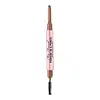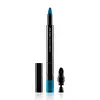Too Faced Pomade In A Pencil Eyebrow Shaper & Filler Versus Shiseido Kajal InkArtist - Shadow, Liner, Brow
What's inside
What's inside
 Key Ingredients
Key Ingredients

 Benefits
Benefits

 Concerns
Concerns

No concerns
 Ingredients Side-by-side
Ingredients Side-by-side

Trimethylsiloxysilicate
EmollientMethyl Trimethicone
Skin ConditioningSynthetic Fluorphlogopite
Polyethylene
AbrasiveDipentaerythrityl Pentaisostearate
EmollientEuphorbia Cerifera Wax
Dimethicone
EmollientPrunus Armeniaca Kernel Oil
MaskingMacadamia Ternifolia Seed Oil
EmollientAluminum Hydroxide
EmollientSorbitan Isostearate
EmulsifyingTocopherol
AntioxidantCI 77891
Cosmetic ColorantCI 77491
Cosmetic ColorantCI 77492
Cosmetic ColorantCI 77499
Cosmetic ColorantTrimethylsiloxysilicate, Methyl Trimethicone, Synthetic Fluorphlogopite, Polyethylene, Dipentaerythrityl Pentaisostearate, Euphorbia Cerifera Wax, Dimethicone, Prunus Armeniaca Kernel Oil, Macadamia Ternifolia Seed Oil, Aluminum Hydroxide, Sorbitan Isostearate, Tocopherol, CI 77891, CI 77491, CI 77492, CI 77499
Dimethicone
EmollientTrimethylsiloxysilicate
EmollientSynthetic Wax
AbrasivePolymethylsilsesquioxane
Octyldodecanol
EmollientCaprylyl Methicone
Skin ConditioningPolyethylene
AbrasiveSynthetic Fluorphlogopite
Stearoxymethicone/Dimethicone Copolymer
EmollientPolyhydroxystearic Acid
EmulsifyingBoron Nitride
AbsorbentMica
Cosmetic ColorantDisteardimonium Hectorite
StabilisingLecithin
EmollientPropylene Carbonate
SolventTocopherol
AntioxidantDicalcium Phosphate
AbrasiveAscorbyl Palmitate
AntioxidantCitric Acid
BufferingUltramarines
CI 77891
Cosmetic ColorantCI 77499
Cosmetic ColorantCI 75470
Cosmetic ColorantCI 77491
Cosmetic ColorantCI 77510
Cosmetic ColorantCI 77492
Cosmetic ColorantCI 19140
Cosmetic ColorantCI 42090
Cosmetic ColorantDimethicone, Trimethylsiloxysilicate, Synthetic Wax, Polymethylsilsesquioxane, Octyldodecanol, Caprylyl Methicone, Polyethylene, Synthetic Fluorphlogopite, Stearoxymethicone/Dimethicone Copolymer, Polyhydroxystearic Acid, Boron Nitride, Mica, Disteardimonium Hectorite, Lecithin, Propylene Carbonate, Tocopherol, Dicalcium Phosphate, Ascorbyl Palmitate, Citric Acid, Ultramarines, CI 77891, CI 77499, CI 75470, CI 77491, CI 77510, CI 77492, CI 19140, CI 42090
Ingredients Explained
These ingredients are found in both products.
Ingredients higher up in an ingredient list are typically present in a larger amount.
Ci 77491 is also hydrated iron III oxide. It's sole purpose is to give a red/pink hue to products.
Iron III oxides are classified as inorganic chemicals for coloring.
Synthetically created Ci 77491 is considered safer than those naturally found. This is because the synthetically created version may contain less impurities. Iron oxides are generally non-toxic and non-allergenic.
Learn more about CI 77491Ci 77492 is also hydrated iron III oxide. It's sole purpose is to give a yellow hue to products.
Iron III oxides are classified as inorganic chemicals for coloring.
Synthetically created Ci 77492 is considered safer than those naturally found. This is because the synthetically created version may contain less impurities. Iron oxides are generally non-toxic and non-allergenic.
Learn more about CI 77492Ci 77499 is also hydrated iron III oxide. It is created from mixing red and black iron oxides. This helps give shades of darkness to a product.
Iron III oxides are classified as inorganic chemicals for coloring.
Ci 77891 is a white pigment from Titanium dioxide. It is naturally found in minerals such as rutile and ilmenite.
It's main function is to add a white color to cosmetics. It can also be mixed with other colors to create different shades.
Ci 77891 is commonly found in sunscreens due to its ability to block UV rays.
Learn more about CI 77891Dimethicone is a type of synthetic silicone created from natural materials such as quartz.
What it does:
Dimethicone comes in different viscosities:
Depending on the viscosity, dimethicone has different properties.
Ingredients lists don't always show which type is used, so we recommend reaching out to the brand if you have questions about the viscosity.
This ingredient is unlikely to cause irritation because it does not get absorbed into skin. However, people with silicone allergies should be careful about using this ingredient.
Note: Dimethicone may contribute to pilling. This is because it is not oil or water soluble, so pilling may occur when layered with products. When mixed with heavy oils in a formula, the outcome is also quite greasy.
Learn more about DimethiconePolyethylene is a synthetic ingredient that helps the skin retain moisture. It is a polymer.
It is also typically used within product formulations to help bind solid ingredients together and thicken oil-based ingredients. When added to balms and emulsions, it helps increase the melting point temperature.
Synthetic Fluorphlogopite is the synthethic version of mica. It consists of fluorine, aluminum and silicate.
Synthetic Fluorphlogopite is used to add volume to products.
It is considered non-irritating on the skin.
Learn more about Synthetic FluorphlogopiteTocopherol (also known as Vitamin E) is a common antioxidant used to help protect the skin from free-radicals and strengthen the skin barrier. It's also fat soluble - this means our skin is great at absorbing it.
Vitamin E also helps keep your natural skin lipids healthy. Your lipid skin barrier naturally consists of lipids, ceramides, and fatty acids. Vitamin E offers extra protection for your skin’s lipid barrier, keeping your skin healthy and nourished.
Another benefit is a bit of UV protection. Vitamin E helps reduce the damage caused by UVB rays. (It should not replace your sunscreen). Combining it with Vitamin C can decrease sunburned cells and hyperpigmentation after UV exposure.
You might have noticed Vitamin E + C often paired together. This is because it is great at stabilizing Vitamin C. Using the two together helps increase the effectiveness of both ingredients.
There are often claims that Vitamin E can reduce/prevent scarring, but these claims haven't been confirmed by scientific research.
Learn more about TocopherolThis silicone is an emollient. Emollients create a thin film on the skin to prevent moisture from escaping.
It is not soluble in water and helps increase water-resistance in products.
According to a manufacturer, it can blend seamlessly with silicone oils, such as Cyclopentasiloxane.
Learn more about Trimethylsiloxysilicate